Clean Cut Fashion: A Social Initiative for Sustainable Fashion Industry
VerifiedAdded on 2023/06/10
|8
|2420
|106
AI Summary
This article discusses the impact of fashion industry on the environment and how Clean Cut Fashion can help. It also talks about the social initiatives that can be taken to reduce the damage caused by textiles and fiber products. The article emphasizes on the importance of educating the people about the negative impacts of the harmful raw products and introducing training programs for the employees of each division of the company.
Contribute Materials
Your contribution can guide someone’s learning journey. Share your
documents today.

Running head: ENTREPRENEURSHIP
ENTREPRENEURSHIP
Name of the Student
Name of the University
Author Note
ENTREPRENEURSHIP
Name of the Student
Name of the University
Author Note
Secure Best Marks with AI Grader
Need help grading? Try our AI Grader for instant feedback on your assignments.

1ENTREPRENEURSHIP
Just like any other fashion-based business, my company the Casa Milla deals with formal
fashion for men and women. Within my time in the organization, I have seen the company rise
from a small company to an organization that deals with export and import of fashion products
internationally. However, over the course of few years, I have noticed several problems for
which I had to include social initiatives for my company. One of the major problems that I have
come crossed is the materials the clothes are made. Fashion industry is in the second rank of the
highest polluting industry, right after the oil industry. It has been reported that the Australian
people throw away around a total amount of 23kg of textile per person in every year.
Considering that amount in place, that would be ton of landfill as synthetic fabrics are reported to
take more than a hundred years to completely biodegrade (Kozlowski, Bardecki and Searcy
2012). The product through which the clothes are produced is much more than natural
biodegradation process of our planet. Now when this hazardous effect is combined with
dangerous working conditions, I have seen how fast it is damaging the environment. As fashion
is one of the most dangerous industries when it is viewed from an environmental perspective, I
will include the method of Clean Cut Fashion to help preserve the environment by introducing
new materials of fashion wear and better process that would not affect the biodegradation
process. The idea of Clean Cut Fashion now exists in most of the popular Australian fashion
brands (Kant Hvass 2014). The products I will introduce would include sustainable fashion
products with the best designers creating the best outfits possible. Research work was mandatory
while doing this as ethical and organic wears include a lot of options to choose from. In
Australia, there is no problem of culture based clothing therefore it was easy for me into
introduce new line of products from renewable materials. Also by introducing charity bin, I
would encourage the people not to throw away their old clothes. The charity bin could donate the
Just like any other fashion-based business, my company the Casa Milla deals with formal
fashion for men and women. Within my time in the organization, I have seen the company rise
from a small company to an organization that deals with export and import of fashion products
internationally. However, over the course of few years, I have noticed several problems for
which I had to include social initiatives for my company. One of the major problems that I have
come crossed is the materials the clothes are made. Fashion industry is in the second rank of the
highest polluting industry, right after the oil industry. It has been reported that the Australian
people throw away around a total amount of 23kg of textile per person in every year.
Considering that amount in place, that would be ton of landfill as synthetic fabrics are reported to
take more than a hundred years to completely biodegrade (Kozlowski, Bardecki and Searcy
2012). The product through which the clothes are produced is much more than natural
biodegradation process of our planet. Now when this hazardous effect is combined with
dangerous working conditions, I have seen how fast it is damaging the environment. As fashion
is one of the most dangerous industries when it is viewed from an environmental perspective, I
will include the method of Clean Cut Fashion to help preserve the environment by introducing
new materials of fashion wear and better process that would not affect the biodegradation
process. The idea of Clean Cut Fashion now exists in most of the popular Australian fashion
brands (Kant Hvass 2014). The products I will introduce would include sustainable fashion
products with the best designers creating the best outfits possible. Research work was mandatory
while doing this as ethical and organic wears include a lot of options to choose from. In
Australia, there is no problem of culture based clothing therefore it was easy for me into
introduce new line of products from renewable materials. Also by introducing charity bin, I
would encourage the people not to throw away their old clothes. The charity bin could donate the
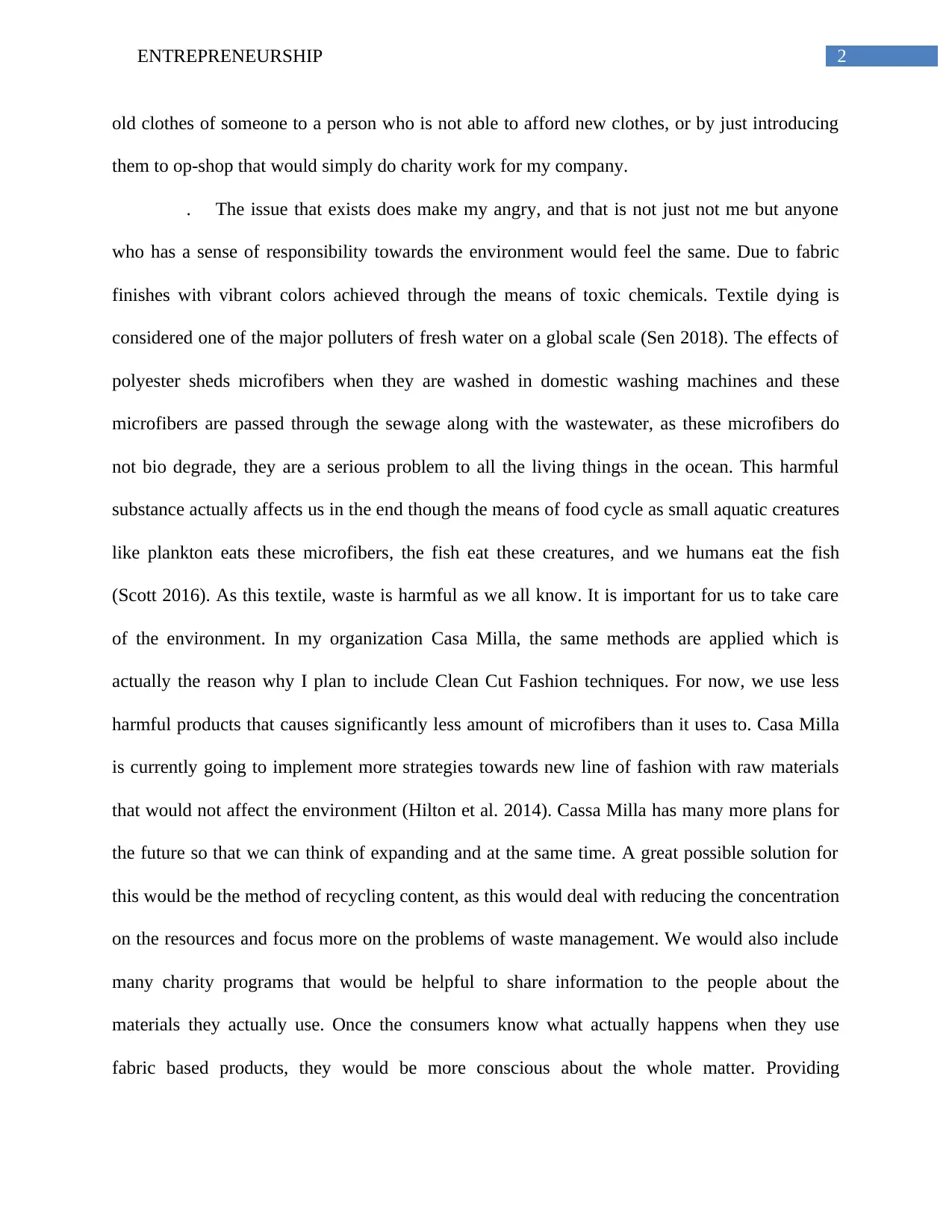
2ENTREPRENEURSHIP
old clothes of someone to a person who is not able to afford new clothes, or by just introducing
them to op-shop that would simply do charity work for my company.
. The issue that exists does make my angry, and that is not just not me but anyone
who has a sense of responsibility towards the environment would feel the same. Due to fabric
finishes with vibrant colors achieved through the means of toxic chemicals. Textile dying is
considered one of the major polluters of fresh water on a global scale (Sen 2018). The effects of
polyester sheds microfibers when they are washed in domestic washing machines and these
microfibers are passed through the sewage along with the wastewater, as these microfibers do
not bio degrade, they are a serious problem to all the living things in the ocean. This harmful
substance actually affects us in the end though the means of food cycle as small aquatic creatures
like plankton eats these microfibers, the fish eat these creatures, and we humans eat the fish
(Scott 2016). As this textile, waste is harmful as we all know. It is important for us to take care
of the environment. In my organization Casa Milla, the same methods are applied which is
actually the reason why I plan to include Clean Cut Fashion techniques. For now, we use less
harmful products that causes significantly less amount of microfibers than it uses to. Casa Milla
is currently going to implement more strategies towards new line of fashion with raw materials
that would not affect the environment (Hilton et al. 2014). Cassa Milla has many more plans for
the future so that we can think of expanding and at the same time. A great possible solution for
this would be the method of recycling content, as this would deal with reducing the concentration
on the resources and focus more on the problems of waste management. We would also include
many charity programs that would be helpful to share information to the people about the
materials they actually use. Once the consumers know what actually happens when they use
fabric based products, they would be more conscious about the whole matter. Providing
old clothes of someone to a person who is not able to afford new clothes, or by just introducing
them to op-shop that would simply do charity work for my company.
. The issue that exists does make my angry, and that is not just not me but anyone
who has a sense of responsibility towards the environment would feel the same. Due to fabric
finishes with vibrant colors achieved through the means of toxic chemicals. Textile dying is
considered one of the major polluters of fresh water on a global scale (Sen 2018). The effects of
polyester sheds microfibers when they are washed in domestic washing machines and these
microfibers are passed through the sewage along with the wastewater, as these microfibers do
not bio degrade, they are a serious problem to all the living things in the ocean. This harmful
substance actually affects us in the end though the means of food cycle as small aquatic creatures
like plankton eats these microfibers, the fish eat these creatures, and we humans eat the fish
(Scott 2016). As this textile, waste is harmful as we all know. It is important for us to take care
of the environment. In my organization Casa Milla, the same methods are applied which is
actually the reason why I plan to include Clean Cut Fashion techniques. For now, we use less
harmful products that causes significantly less amount of microfibers than it uses to. Casa Milla
is currently going to implement more strategies towards new line of fashion with raw materials
that would not affect the environment (Hilton et al. 2014). Cassa Milla has many more plans for
the future so that we can think of expanding and at the same time. A great possible solution for
this would be the method of recycling content, as this would deal with reducing the concentration
on the resources and focus more on the problems of waste management. We would also include
many charity programs that would be helpful to share information to the people about the
materials they actually use. Once the consumers know what actually happens when they use
fabric based products, they would be more conscious about the whole matter. Providing
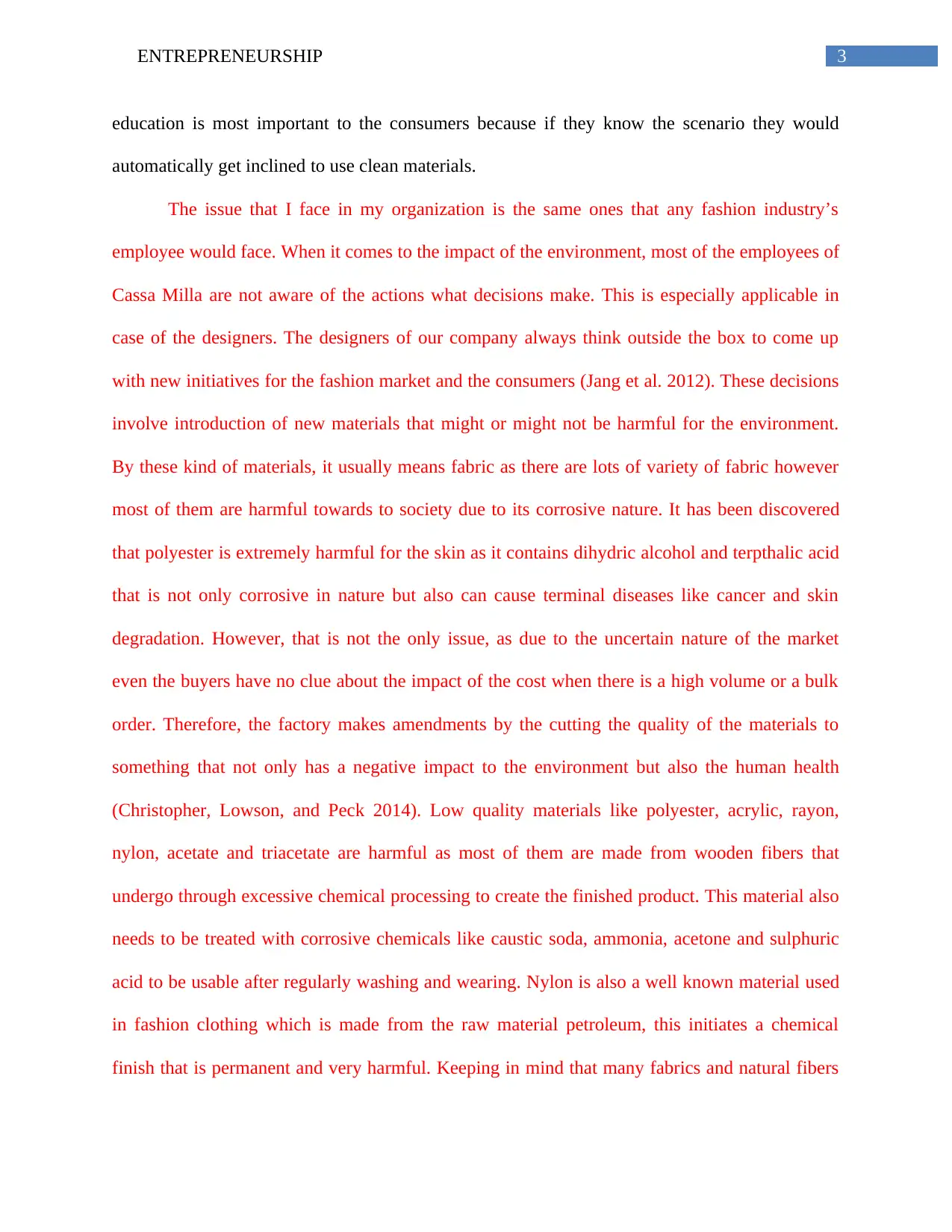
3ENTREPRENEURSHIP
education is most important to the consumers because if they know the scenario they would
automatically get inclined to use clean materials.
The issue that I face in my organization is the same ones that any fashion industry’s
employee would face. When it comes to the impact of the environment, most of the employees of
Cassa Milla are not aware of the actions what decisions make. This is especially applicable in
case of the designers. The designers of our company always think outside the box to come up
with new initiatives for the fashion market and the consumers (Jang et al. 2012). These decisions
involve introduction of new materials that might or might not be harmful for the environment.
By these kind of materials, it usually means fabric as there are lots of variety of fabric however
most of them are harmful towards to society due to its corrosive nature. It has been discovered
that polyester is extremely harmful for the skin as it contains dihydric alcohol and terpthalic acid
that is not only corrosive in nature but also can cause terminal diseases like cancer and skin
degradation. However, that is not the only issue, as due to the uncertain nature of the market
even the buyers have no clue about the impact of the cost when there is a high volume or a bulk
order. Therefore, the factory makes amendments by the cutting the quality of the materials to
something that not only has a negative impact to the environment but also the human health
(Christopher, Lowson, and Peck 2014). Low quality materials like polyester, acrylic, rayon,
nylon, acetate and triacetate are harmful as most of them are made from wooden fibers that
undergo through excessive chemical processing to create the finished product. This material also
needs to be treated with corrosive chemicals like caustic soda, ammonia, acetone and sulphuric
acid to be usable after regularly washing and wearing. Nylon is also a well known material used
in fashion clothing which is made from the raw material petroleum, this initiates a chemical
finish that is permanent and very harmful. Keeping in mind that many fabrics and natural fibers
education is most important to the consumers because if they know the scenario they would
automatically get inclined to use clean materials.
The issue that I face in my organization is the same ones that any fashion industry’s
employee would face. When it comes to the impact of the environment, most of the employees of
Cassa Milla are not aware of the actions what decisions make. This is especially applicable in
case of the designers. The designers of our company always think outside the box to come up
with new initiatives for the fashion market and the consumers (Jang et al. 2012). These decisions
involve introduction of new materials that might or might not be harmful for the environment.
By these kind of materials, it usually means fabric as there are lots of variety of fabric however
most of them are harmful towards to society due to its corrosive nature. It has been discovered
that polyester is extremely harmful for the skin as it contains dihydric alcohol and terpthalic acid
that is not only corrosive in nature but also can cause terminal diseases like cancer and skin
degradation. However, that is not the only issue, as due to the uncertain nature of the market
even the buyers have no clue about the impact of the cost when there is a high volume or a bulk
order. Therefore, the factory makes amendments by the cutting the quality of the materials to
something that not only has a negative impact to the environment but also the human health
(Christopher, Lowson, and Peck 2014). Low quality materials like polyester, acrylic, rayon,
nylon, acetate and triacetate are harmful as most of them are made from wooden fibers that
undergo through excessive chemical processing to create the finished product. This material also
needs to be treated with corrosive chemicals like caustic soda, ammonia, acetone and sulphuric
acid to be usable after regularly washing and wearing. Nylon is also a well known material used
in fashion clothing which is made from the raw material petroleum, this initiates a chemical
finish that is permanent and very harmful. Keeping in mind that many fabrics and natural fibers
Secure Best Marks with AI Grader
Need help grading? Try our AI Grader for instant feedback on your assignments.
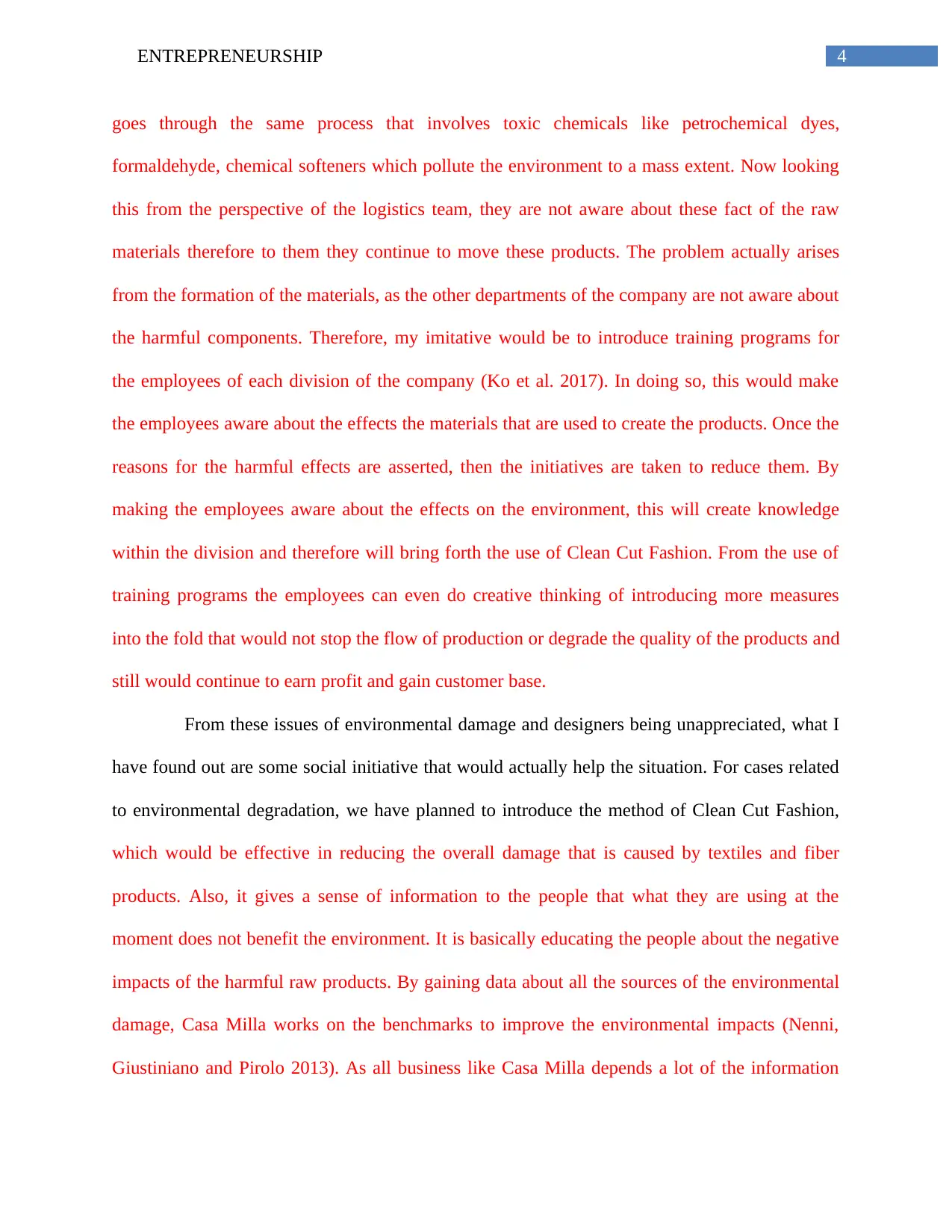
4ENTREPRENEURSHIP
goes through the same process that involves toxic chemicals like petrochemical dyes,
formaldehyde, chemical softeners which pollute the environment to a mass extent. Now looking
this from the perspective of the logistics team, they are not aware about these fact of the raw
materials therefore to them they continue to move these products. The problem actually arises
from the formation of the materials, as the other departments of the company are not aware about
the harmful components. Therefore, my imitative would be to introduce training programs for
the employees of each division of the company (Ko et al. 2017). In doing so, this would make
the employees aware about the effects the materials that are used to create the products. Once the
reasons for the harmful effects are asserted, then the initiatives are taken to reduce them. By
making the employees aware about the effects on the environment, this will create knowledge
within the division and therefore will bring forth the use of Clean Cut Fashion. From the use of
training programs the employees can even do creative thinking of introducing more measures
into the fold that would not stop the flow of production or degrade the quality of the products and
still would continue to earn profit and gain customer base.
From these issues of environmental damage and designers being unappreciated, what I
have found out are some social initiative that would actually help the situation. For cases related
to environmental degradation, we have planned to introduce the method of Clean Cut Fashion,
which would be effective in reducing the overall damage that is caused by textiles and fiber
products. Also, it gives a sense of information to the people that what they are using at the
moment does not benefit the environment. It is basically educating the people about the negative
impacts of the harmful raw products. By gaining data about all the sources of the environmental
damage, Casa Milla works on the benchmarks to improve the environmental impacts (Nenni,
Giustiniano and Pirolo 2013). As all business like Casa Milla depends a lot of the information
goes through the same process that involves toxic chemicals like petrochemical dyes,
formaldehyde, chemical softeners which pollute the environment to a mass extent. Now looking
this from the perspective of the logistics team, they are not aware about these fact of the raw
materials therefore to them they continue to move these products. The problem actually arises
from the formation of the materials, as the other departments of the company are not aware about
the harmful components. Therefore, my imitative would be to introduce training programs for
the employees of each division of the company (Ko et al. 2017). In doing so, this would make
the employees aware about the effects the materials that are used to create the products. Once the
reasons for the harmful effects are asserted, then the initiatives are taken to reduce them. By
making the employees aware about the effects on the environment, this will create knowledge
within the division and therefore will bring forth the use of Clean Cut Fashion. From the use of
training programs the employees can even do creative thinking of introducing more measures
into the fold that would not stop the flow of production or degrade the quality of the products and
still would continue to earn profit and gain customer base.
From these issues of environmental damage and designers being unappreciated, what I
have found out are some social initiative that would actually help the situation. For cases related
to environmental degradation, we have planned to introduce the method of Clean Cut Fashion,
which would be effective in reducing the overall damage that is caused by textiles and fiber
products. Also, it gives a sense of information to the people that what they are using at the
moment does not benefit the environment. It is basically educating the people about the negative
impacts of the harmful raw products. By gaining data about all the sources of the environmental
damage, Casa Milla works on the benchmarks to improve the environmental impacts (Nenni,
Giustiniano and Pirolo 2013). As all business like Casa Milla depends a lot of the information
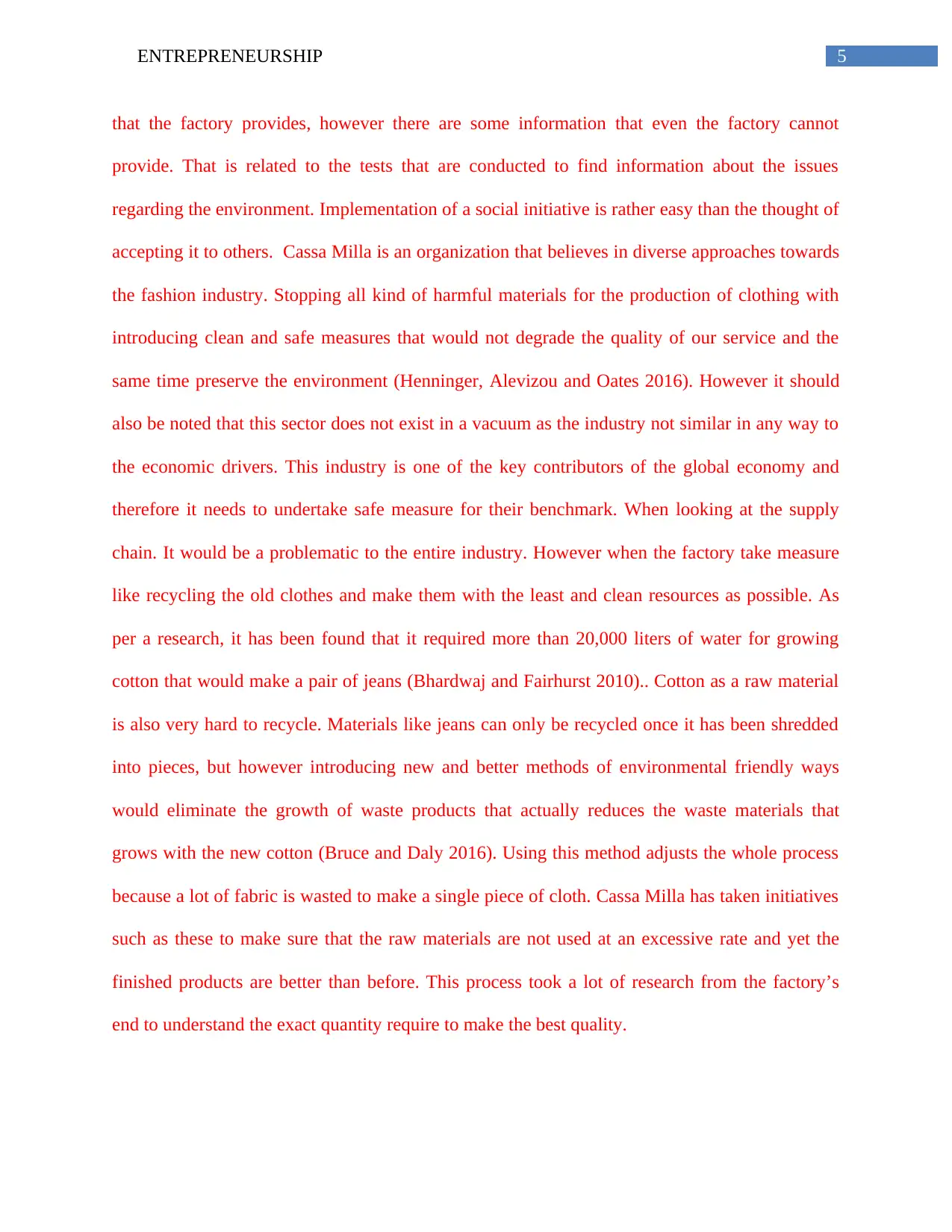
5ENTREPRENEURSHIP
that the factory provides, however there are some information that even the factory cannot
provide. That is related to the tests that are conducted to find information about the issues
regarding the environment. Implementation of a social initiative is rather easy than the thought of
accepting it to others. Cassa Milla is an organization that believes in diverse approaches towards
the fashion industry. Stopping all kind of harmful materials for the production of clothing with
introducing clean and safe measures that would not degrade the quality of our service and the
same time preserve the environment (Henninger, Alevizou and Oates 2016). However it should
also be noted that this sector does not exist in a vacuum as the industry not similar in any way to
the economic drivers. This industry is one of the key contributors of the global economy and
therefore it needs to undertake safe measure for their benchmark. When looking at the supply
chain. It would be a problematic to the entire industry. However when the factory take measure
like recycling the old clothes and make them with the least and clean resources as possible. As
per a research, it has been found that it required more than 20,000 liters of water for growing
cotton that would make a pair of jeans (Bhardwaj and Fairhurst 2010).. Cotton as a raw material
is also very hard to recycle. Materials like jeans can only be recycled once it has been shredded
into pieces, but however introducing new and better methods of environmental friendly ways
would eliminate the growth of waste products that actually reduces the waste materials that
grows with the new cotton (Bruce and Daly 2016). Using this method adjusts the whole process
because a lot of fabric is wasted to make a single piece of cloth. Cassa Milla has taken initiatives
such as these to make sure that the raw materials are not used at an excessive rate and yet the
finished products are better than before. This process took a lot of research from the factory’s
end to understand the exact quantity require to make the best quality.
that the factory provides, however there are some information that even the factory cannot
provide. That is related to the tests that are conducted to find information about the issues
regarding the environment. Implementation of a social initiative is rather easy than the thought of
accepting it to others. Cassa Milla is an organization that believes in diverse approaches towards
the fashion industry. Stopping all kind of harmful materials for the production of clothing with
introducing clean and safe measures that would not degrade the quality of our service and the
same time preserve the environment (Henninger, Alevizou and Oates 2016). However it should
also be noted that this sector does not exist in a vacuum as the industry not similar in any way to
the economic drivers. This industry is one of the key contributors of the global economy and
therefore it needs to undertake safe measure for their benchmark. When looking at the supply
chain. It would be a problematic to the entire industry. However when the factory take measure
like recycling the old clothes and make them with the least and clean resources as possible. As
per a research, it has been found that it required more than 20,000 liters of water for growing
cotton that would make a pair of jeans (Bhardwaj and Fairhurst 2010).. Cotton as a raw material
is also very hard to recycle. Materials like jeans can only be recycled once it has been shredded
into pieces, but however introducing new and better methods of environmental friendly ways
would eliminate the growth of waste products that actually reduces the waste materials that
grows with the new cotton (Bruce and Daly 2016). Using this method adjusts the whole process
because a lot of fabric is wasted to make a single piece of cloth. Cassa Milla has taken initiatives
such as these to make sure that the raw materials are not used at an excessive rate and yet the
finished products are better than before. This process took a lot of research from the factory’s
end to understand the exact quantity require to make the best quality.

6ENTREPRENEURSHIP
REFERENCES
Bhardwaj, V. and Fairhurst, A., 2010. Fast fashion: response to changes in the fashion
industry. The International Review of Retail, Distribution and Consumer Research, 20(1),
pp.165-173.
Bruce, M. and Daly, L., 2016. Buyer behaviour for fast fashion. Journal of Fashion Marketing
and Management: An International Journal, 10(3), pp.329-344.
Christopher, M., Lowson, R. and Peck, H., 2014. Creating agile supply chains in the fashion
industry. International Journal of Retail & Distribution Management, 32(8), pp.367-376.
Henninger, C.E., Alevizou, P.J. and Oates, C.J., 2016. What is sustainable fashion?. Journal of
Fashion Marketing and Management: An International Journal, 20(4), pp.400-416.
Hilton, B., Choi, C.J. and Chen, S., 2014. The ethics of counterfeiting in the fashion industry:
Quality, credence and profit issues. Journal of Business Ethics, 55(4), pp.343-352.
Jang, J., Ko, E., Chun, E. and Lee, E., 2012. A study of a social content model for sustainable
development in the fast fashion industry. Journal of Global Fashion Marketing, 3(2), pp.61-70.
Kant Hvass, K., 2014. Post-retail responsibility of garments–a fashion industry
perspective. Journal of Fashion Marketing and Management, 18(4), pp.413-430.
REFERENCES
Bhardwaj, V. and Fairhurst, A., 2010. Fast fashion: response to changes in the fashion
industry. The International Review of Retail, Distribution and Consumer Research, 20(1),
pp.165-173.
Bruce, M. and Daly, L., 2016. Buyer behaviour for fast fashion. Journal of Fashion Marketing
and Management: An International Journal, 10(3), pp.329-344.
Christopher, M., Lowson, R. and Peck, H., 2014. Creating agile supply chains in the fashion
industry. International Journal of Retail & Distribution Management, 32(8), pp.367-376.
Henninger, C.E., Alevizou, P.J. and Oates, C.J., 2016. What is sustainable fashion?. Journal of
Fashion Marketing and Management: An International Journal, 20(4), pp.400-416.
Hilton, B., Choi, C.J. and Chen, S., 2014. The ethics of counterfeiting in the fashion industry:
Quality, credence and profit issues. Journal of Business Ethics, 55(4), pp.343-352.
Jang, J., Ko, E., Chun, E. and Lee, E., 2012. A study of a social content model for sustainable
development in the fast fashion industry. Journal of Global Fashion Marketing, 3(2), pp.61-70.
Kant Hvass, K., 2014. Post-retail responsibility of garments–a fashion industry
perspective. Journal of Fashion Marketing and Management, 18(4), pp.413-430.
Paraphrase This Document
Need a fresh take? Get an instant paraphrase of this document with our AI Paraphraser
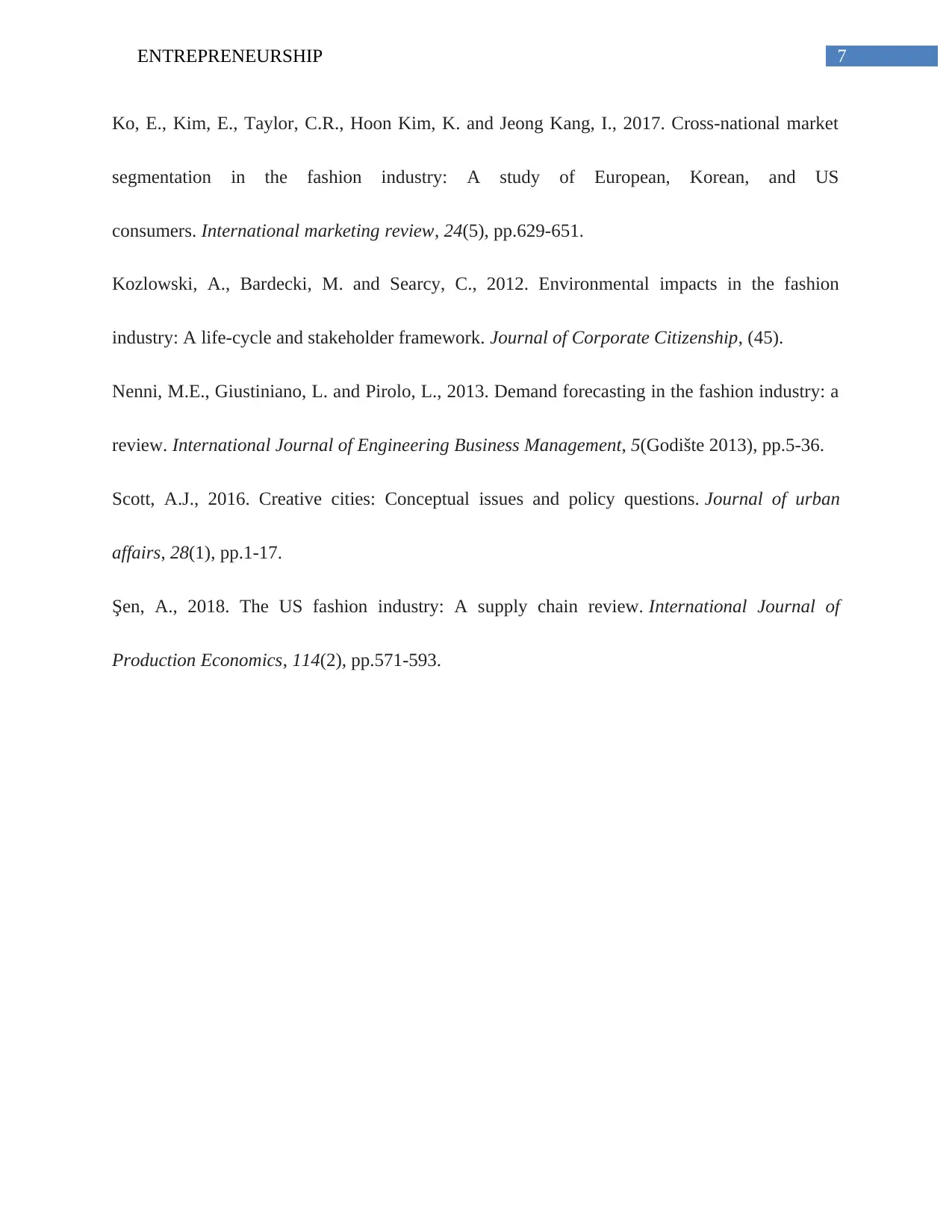
7ENTREPRENEURSHIP
Ko, E., Kim, E., Taylor, C.R., Hoon Kim, K. and Jeong Kang, I., 2017. Cross-national market
segmentation in the fashion industry: A study of European, Korean, and US
consumers. International marketing review, 24(5), pp.629-651.
Kozlowski, A., Bardecki, M. and Searcy, C., 2012. Environmental impacts in the fashion
industry: A life-cycle and stakeholder framework. Journal of Corporate Citizenship, (45).
Nenni, M.E., Giustiniano, L. and Pirolo, L., 2013. Demand forecasting in the fashion industry: a
review. International Journal of Engineering Business Management, 5(Godište 2013), pp.5-36.
Scott, A.J., 2016. Creative cities: Conceptual issues and policy questions. Journal of urban
affairs, 28(1), pp.1-17.
Şen, A., 2018. The US fashion industry: A supply chain review. International Journal of
Production Economics, 114(2), pp.571-593.
Ko, E., Kim, E., Taylor, C.R., Hoon Kim, K. and Jeong Kang, I., 2017. Cross-national market
segmentation in the fashion industry: A study of European, Korean, and US
consumers. International marketing review, 24(5), pp.629-651.
Kozlowski, A., Bardecki, M. and Searcy, C., 2012. Environmental impacts in the fashion
industry: A life-cycle and stakeholder framework. Journal of Corporate Citizenship, (45).
Nenni, M.E., Giustiniano, L. and Pirolo, L., 2013. Demand forecasting in the fashion industry: a
review. International Journal of Engineering Business Management, 5(Godište 2013), pp.5-36.
Scott, A.J., 2016. Creative cities: Conceptual issues and policy questions. Journal of urban
affairs, 28(1), pp.1-17.
Şen, A., 2018. The US fashion industry: A supply chain review. International Journal of
Production Economics, 114(2), pp.571-593.
1 out of 8
Your All-in-One AI-Powered Toolkit for Academic Success.
+13062052269
info@desklib.com
Available 24*7 on WhatsApp / Email
![[object Object]](/_next/static/media/star-bottom.7253800d.svg)
Unlock your academic potential
© 2024 | Zucol Services PVT LTD | All rights reserved.